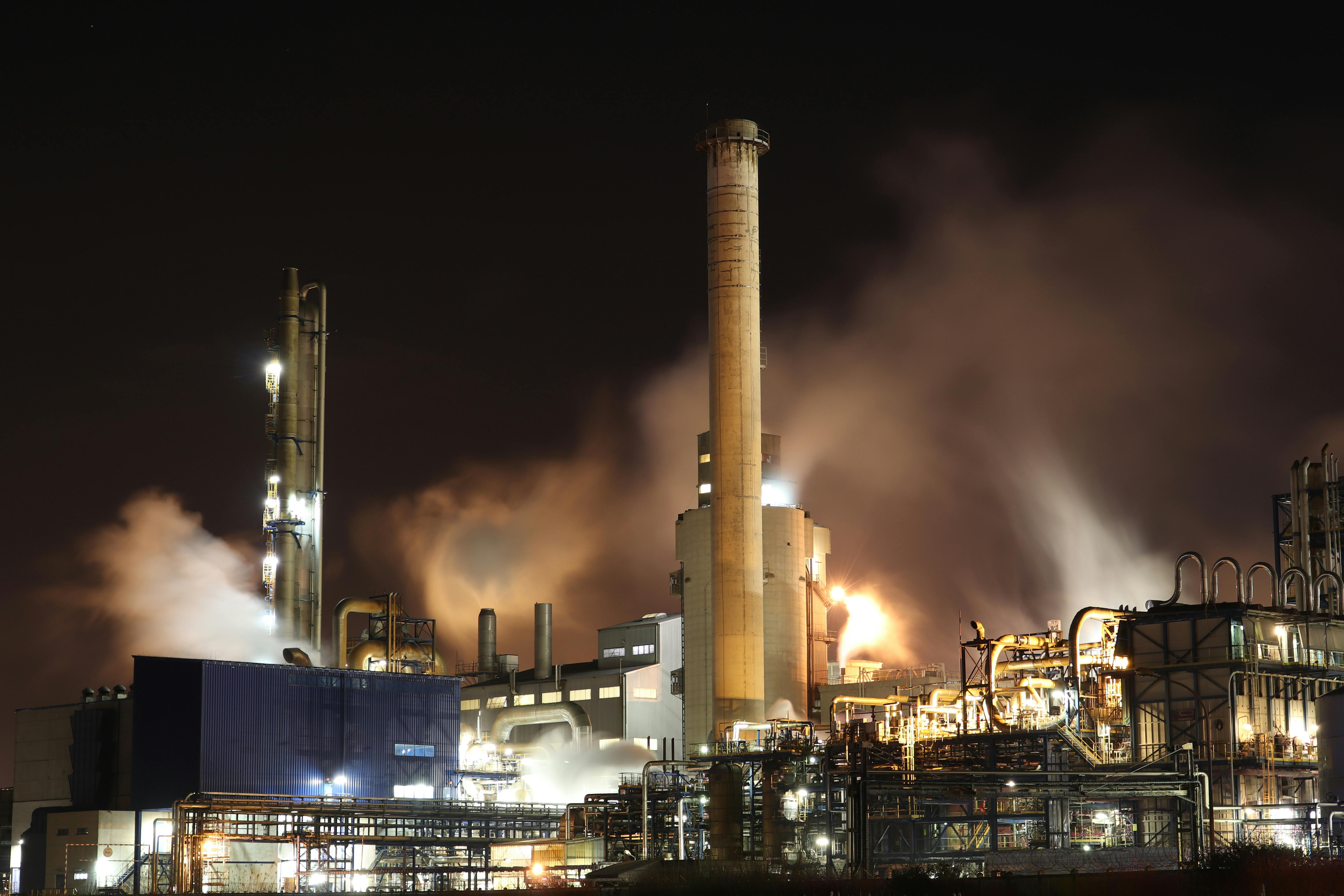Fractional distillation of petroleum is a process used to separate crude oil into its component parts, or fractions. It involves heating the crude oil to extremely high temperatures in a fractionating column and allowing it to vaporize. The vapors are then condensed and collected according to their boiling points, allowing different hydrocarbon compounds to be isolated and recovered as individual products. Fractional distillation is one of the most important processes used in the refining of petroleum, providing an efficient way to produce gasoline, diesel fuel, kerosene, lubricating oils, and other products from crude oil.Fractional distillation of petroleum is a process of separating different components of crude oil by heating it to very high temperatures and then condensing the resulting vapours into liquid fractions. It is a continuous process that involves the separation of the different hydrocarbons in crude oil based on their relative boiling points. The fractions are then further processed into various products such as petrol, diesel, kerosene and lubricating oils.
Fractional Distillation
Fractional distillation is a process used to separate a mixture of liquids that have different boiling points. It is a type of distillation that involves repeated distillation of the same mixture in order to separate the components of the mixture. The process involves heating the mixture until it boils, collecting and condensing the vapors as they rise, and then allowing them to cool and separate into their component parts. Fractional distillation is an important part of many industrial processes and is used in the production of various products such as fuel, pharmaceuticals, perfumes, and petrochemicals.
The steps involved in fractional distillation are as follows:
- Step 1: Prepare the Mixture – The first step in fractional distillation is to prepare the mixture for separation. This involves heating the mixture until it begins to boil.
- Step 2: Collect and Condense Vapors – As the mixture boils, vapors are released into the atmosphere. These vapors can be collected and condensed into separate containers for further analysis.
<
How Does Fractional Distillation Work?
Fractional distillation is a process used to separate mixtures of liquids that have different boiling points. It is an effective method for separating the components of crude oil, which have different boiling points and densities. The process involves heating the mixture until its components vaporize, cooling the vapor so that it condenses, and then collecting and separating it into fractions.
The first step in fractional distillation is to heat the mixture until its components vaporize. This is usually done at a temperature slightly higher than the boiling point of the component with the highest boiling point in the mixture. As the mixture heats up, some of its components will boil off as vapor and rise above the liquid surface, while others will remain in liquid form.
Once all of the components have been vaporized, they are cooled so that they condense back into liquid form. This cooling is usually done by passing air through a condenser coil that surrounds the column where the vaporized components are located. As the air passes around this coil, it cools down and causes some of the vapors
Fractional Distillation Unit Components
The fractional distillation unit is the most important component of any distillation process. It is a system of interconnected components, such as a still pot, condenser, and rectifier, that are used to separate mixtures of liquids with different boiling points. The fractional distillation unit is composed of several components, including a gas inlet, reflux condenser, boiler, rectifying column, and take-off point.
The gas inlet is the first component in the fractional distillation unit. This component supplies the vaporized liquid to the system and helps to regulate the temperature in the still pot. The reflux condenser helps to cool down the vapor before it enters the boiler and prevents it from reverting back into liquid form.
The boiler is where heat is applied to vaporize liquids and separate them from each other according to their boiling points. The rectifying column acts as a filter for separating out different fractions of liquids at different heights within the column. At the top of this column lies a take-off point which allows you to draw off or collect specific fractions for use or further processing.
Benefits of Fractional Distillation
Fractional distillation is a process used to separate liquids based on their boiling points. This process has many benefits, including the ability to purify compounds, producing high-quality products, and providing a cost-effective method of separating liquids with a wide range of boiling points.
Purification of Compounds
One of the main advantages of fractional distillation is the ability to purify compounds. This process can separate out impurities such as acids, bases, and inorganic salts from organic compounds. In addition, fractional distillation can also be used to separate different types of compounds from each other that have very similar boiling points.
High Quality Products
The use of fractional distillation also results in high quality products. The process is able to separate out impurities and unwanted elements that would otherwise be present in the final product. In addition, it helps to concentrate specific components in the mixture thus yielding higher purity and quality products.
Cost Effective Method
Fractional

Petroleum Crude vs Petroleum Products
Petroleum crude is the raw, unrefined form of petroleum which is extracted from the ground through drilling. It is a complex mixture of hydrocarbons, with varying amounts of sulfur, oxygen and nitrogen. It can be further refined to produce a range of petroleum products. These products include fuels like gasoline, diesel, and jet fuel; lubricants like motor oil and transmission fluid; and petrochemicals used to make plastics, solvents, and other materials.
The primary difference between petroleum crude and petroleum products lies in their physical form. Petroleum crude is a thick black liquid that must be processed in order to produce useable petroleum products. Products are lighter in color, with different consistencies depending on the type of product being created. For example, gasoline is a light-colored liquid while motor oil is thicker and darker in color.
Another significant difference between crude oil and petroleum products lies in their composition. Crude oil contains a wide variety of hydrocarbons as well as sulfur, oxygen and nitrogen compounds which must be removed or converted in order to produce usable fuels
Petroleum Products
Petroleum products are essential components of modern life and are used all over the world. Petroleum is a naturally occurring, flammable liquid found both in crude form and refined products, such as gasoline, diesel fuel, kerosene, heating oil, asphalt base, jet fuel, lubricating oils and waxes. Petroleum products can be divided into two broad categories: refined products and crude oil. Refined petroleum products include gasoline, diesel fuel, propane and other fuels. Crude oil consists of a mix of hydrocarbons that can be refined into various useful products.
Gasoline is the most widely used petroleum product in the world today. It is primarily used as a motor fuel for vehicles and engines powered by internal combustion engines. Gasoline contains hydrocarbons that are highly flammable and explosive when ignited. Diesel fuel is a petroleum-based product commonly used to power trucks, buses and other heavy-duty vehicles. It has a higher energy content than gasoline but produces more pollutants when burned.
Kerosene is another popular petroleum product typically used as a heating fuel or to power jet
What Factors Determine the Types of Products Produced by Fractional Distillation?
Fractional distillation is a process used to separate and purify different components of a liquid or gas mixture. The components are separated based on the different boiling points of the components. The boiling points of the components are determined by a variety of factors, including their molecular weight, structure, and intermolecular forces.
The most important factor that determines the types of products produced by fractional distillation is the boiling point of each component in the mixture. As each component has its own unique boiling point, when heated, it will vaporize at that temperature and be collected in a separate vessel. This allows for the separation of components with different boiling points from one another.
Other factors such as pressure, temperature control, and reflux ratio all play an important role in determining which products are produced through fractional distillation. Pressure affects how quickly each component vaporizes and how much can be collected at once from the mixture. Temperature control ensures that only components with lower boiling points are vaporized before those with higher ones, allowing for more accurate separation. Finally, reflux ratio

Conclusion
Fractional distillation of petroleum is an important process in the refining of crude oil into gasoline, diesel, and other fuels. It is a complex process that involves heating the crude oil to very high temperatures and then separating it into fractions. The fractions are then further processed to produce the desired fuel products. This process helps to maximize the efficiency of the refining process and ensure that only quality products are produced for use in vehicles and other applications.
Fractional distillation is a critical step in the refining process and must be done correctly to ensure that all desired products can be produced from each batch of crude oil. By understanding how fractional distillation works, refiners can work more effectively to produce high-quality fuels from their crude oil inputs.

